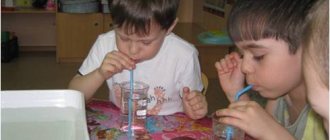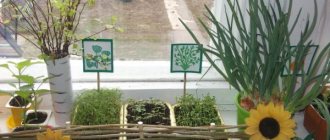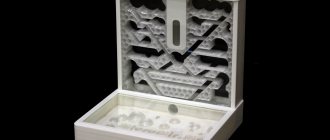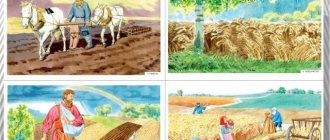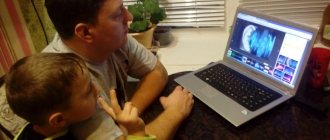Cognitive and research project “Invisible Air” in the senior group.
Educator: Take a plastic bag. What's in it?
Children: It's empty.
Educator: It can be folded several times. Look how thin he is. Now we fill the bag with air and twist it. The bag is full of air, it looks like a pillow. The air took up all the space in the bag. Now let's untie the bag and let the air out of it. The package became thin again. Why?
Children: There is no air in it.
Educator: Look, Kuzya! Conclusion: the air is transparent, to see it, you need to catch it. And we were able to do it! We caught the air and locked it in a bag, and then released it.
Kuzya: This bag reminded me of something! In the summer I saw people using such “locked” air! On the river! It looked like it was an air mattress! I also saw children wearing lifeguards and even a lifebuoy!
Educator: Of course, Kuzya! After all, air is lighter than water! And if there is air inside the mattress, then, of course, it floats!
Kuzya: So, if there is air inside something, it will float? Guys, help me sort out the toys: which ones will float and which ones won’t? Where did the air hide?
Didactic game “Where is the air hidden?”
(children take turns taking toys from Cousin’s chest and laying them out on 2 trays)
Educator: Well done, guys! Help Kuza! Now you know, Kuzya, that objects with air inside will float. But be careful, if water gets in and air is pushed out, the item may sink.
Kuzya: Now I know: inside objects, where it seems empty, there is air hidden there. But I wonder, is there air inside a person?
Educator: What do you think, guys? Let's check?
Experiment 2. Blow into a tube placed in a glass of water.
Educator: Blow into a tube placed in a glass of water. What's happening?
Children: Bubbles come out.
Educator: You see! Conclusion: this means there is air inside us. We blow into the tube and he comes out. But in order to blow more, we first inhale new air, and then exhale through the tube and we get bubbles. Guys, what other bubbles can you blow?
Children: Soapy.
Educator: Let's blow soap bubbles too.
F/m “Soap Bubbles” (to music)
Educator: Kuzya, what do you think is inside the soap bubbles?
Kuzya: Of course, soap!
Educator: Guys, is Kuzya right? Why? Of course, each bubble contains air inside. This soap film is filled with air and comes off the loop. Lungs filled with air bubbles float in the air.
Kuzya: I see! You exhale. It means it is inside you. But how does it get to you? Through the nose?
Educator: Of course! All people breathe through their nose. Guys, let's show Kuza how our noses breathe. When we simply inhale and exhale air, do we see it?
Project in the senior group “Invisible Air”
Galina Monastyreva
Project in the senior group “Invisible Air”
Project “ Air is invisible ”
Project motto : Everything is interesting - what is unknown!
Relevance: Air is a magician who is capable of performing many miracles. It can lift a sunken ship from the seabed, make possible the smooth flight of an airship and the rapid movement of aircraft. The preschooler has lived in the world for several years and is accustomed to encountering air everywhere . But a child is not yet able to learn on his own, to study its properties, to find out what he had not thought about before or had no idea about. Currently, in connection with the revision of priority forms and methods of teaching in preschool education, it is precisely the methods that develop children’s abilities for initial forms of generalization, inference, and abstraction that predominate. And this method is experimentation.
The task of adults is to help children develop an active desire to experiment; create optimal conditions for the development of creative, independent and joint activity of students through a variety of experimental and artistic activities.
Goal: to form children’s ideas about air and its properties through search and research activities.
Tasks:
Educational:
• introduce children to air , its properties and role in the life of humans and animals;
• deepen and expand children's knowledge about air through experiments ;
Educational:
• create conditions for conducting experiments and experimentation, using instruments and materials from the experimentation center;
• develop in children speech activity, observation, ability to draw conclusions, predict results;
• form the habit of asking questions and seeking answers to them through experience;
Educational:
• cultivate respect for the environment, safe behavior during experiments and in nature;
Expected Result:
children will enrich their understanding of some properties of air ;
learn to set tasks independently:
invent and perform experiments using substitute objects; from the idea to go to a specific result.
Project participants : senior , teachers, parents.
Project type : research, short-term (2 weeks)
.
Contents of work on the project in stages :
Preparatory stage.
Defining the goals and objectives of the project .
design stage .
Main stage.
Implementation of main activities in the project .
The final stage.
Includes the collection and processing of methodological and practical materials, correlation of the delivered and predicted results with the obtained ones; generalization of project .
Planning and organization of activities:
Stage 1 – preparatory.
№
Subject Contents of activity Responsible Timeframe
1 Determining the topic of the project : introducing children to basic concepts. Teacher 1st day
2 Drawing up a work plan for the implementation of “ Air is invisible ” project
. Teacher parents day 1
3 Design of the parent corner: posting articles, consultations. teacher 2nd day
4. Selection of visual and didactic aids, games, and demonstrative material for classes. teacher 2nd day
Stage 2 - main
№
Subject Contents of activity Responsible Timeframe
1 Conversation on the topic: “How to hear the air ?”
. Reading a poem
S. Marshak “Soap Bubbles”
.
Experiments “Search for
air ” ,
“What’s in the bag?”
. Teacher 3rd day
2
Making a fan (breeze)
from paper.
Game exercise “The wind blows in our faces”
Teacher Day 4
3 Wind observation. P/n "bubble"
.
Experiment “How does
air ?” Teacher 5th day
4 Consultation for parents “Experimenting at home”
Reading the fairy tale Iris Review “Good Air ”
Teacher 6th day
5 Open GCD for drawing using non-traditional techniques (drawing by blowing + candle)
“Winter Park”
. Teacher 7th day
6 Reading I. Tokmakov “Windy, windy”
.
"Bouncing Coin"
experiment .
View the presentation "
Air " . Teacher 8th day
7 Conversation “How things work thanks to air ”
Experience
"Storm in a teacup"
. Teacher 9th day
8 Experiment “ Air has weight ”
Watching the cartoon “Formula of the Mind”
Teacher day 10
9 Conversation “ Air ”
.
Riddles about air transport . Launching "flashlights"
. Teacher Day 11
Stage 3 – final
№
Subject Contents of activity Responsible Timeframe
1 Exhibition of drawings “We need clean air ”
. Teacher, parents Day 12
2 Processing and design of project . Teacher Day 13
3 Performance analysis. Album design “We are experimenting”
. Teacher day 14
Photo report
Experience "Storm in a teacup"
Experiment “The balloon also has air ”
"What's in the bag" experience
Wind is the movement of air . Making a breeze out of paper.
Joint creative activity of children and parents “We need clean air ”
Air-invisibility
Key words : air, atmosphere, encyclopedia.
Introduction. My name is Anya, I go to kindergarten. I have many friends with whom I like to play, do all sorts of interesting things - conduct experiments and experiments. I really want to share with you my impressions of the most interesting research in my life! One day I watched a cartoon before going to bed, “Why. What is air? In this cartoon I heard that air is what we breathe, it has no smell, taste and shape. I decided, at all costs, to find out everything about the air.
Goal: get acquainted with the properties of air and create a mini-museum “Air”.
I needed to solve the following problems:
- Collect information about the air;
- Find out where the air is, what properties it has;
- Find out who needs air and why;
- Present the research results to your peers.
- Design a mini-museum “Air”.
I suggested the following : if I learn about the properties of air, I can create a mini-museum “Air”.
Main part
Reading the encyclopedia with Aigul Rakhimovna, I learned that air surrounds us everywhere: on the street, in a group, in any room. The air cannot be seen, but it can be felt if you suddenly wave your hand, bend over sharply, or run. Feel it even when the wind blows, because wind is the movement of air. From books and stories, I learned that man has long learned to use air as a source of energy. Air has strength and mobility. The earth is surrounded by a layer of air called the atmosphere. Air consists of several gases. One of them is oxygen, which is necessary for humans and animals to breathe and live. Together with my mother, we found information about air on the Internet: The Earth is surrounded by a layer of air called the atmosphere. Air consists of several gases. One of them is oxygen, which is necessary for humans and animals to breathe and live. From everything I learned, we assumed that the air:
- this is not a solid body, not a liquid, but something else;
− invisible;
− located everywhere;
− perceptible;
- everyone needs it.
As a group, we began testing our hypotheses.
- Is air not a solid, not a liquid, but something else?
We took a stone in our hand and tried to squeeze it.
A stone is a solid body. Is it possible to take air in your hand and squeeze it? No you can not.
We confirm our hypothesis: air is not a solid body.
We took a glass of water, looked and smelled. Water can flow, murmur, stream, and run. This means that water is a liquid. We also know such liquids as: juice, milk, jelly, kefir. Air does not flow, it cannot be drunk, which means it is not a liquid. We can conclude: air is not a liquid.
In the encyclopedia we learned that air is a gas.
- Air is invisible.
In order to determine this, we took a plastic bag; it was empty. When we began to twist the bag from the open end, it inflated and became convex. This means there is something in the package. We came to the conclusion that there is something in the package, but we don't see it. Thus, our second hypothesis was confirmed - the air is transparent and invisible.
- Air is everywhere.
We think that air is everywhere. Let's check it out.
Let's take a rubber toy and squeeze it in our hand. We heard a whistle. This is the air coming out of the pear with noise. Let's close the hole of the rubber toy with our finger and try to squeeze it. She doesn't shrink. What's stopping this? Air.
Conclusion: the air in the toy prevents it from being compressed.
I wonder if there is air in the chalk?
We think that there is air in the chalk, since it is solid. In order to check this, we took a glass of water and dipped a piece of chalk into it. You can see that air bubbles are coming out of the chalk. Conclusion: there is air in the chalk.
Conclusion: air is everywhere.
- We can feel the air.
From encyclopedias we learned that the movement of air in nature is called wind. We can feel the movement of air. In order to check this, we took a fan and waved it near our face. We felt a breeze blowing. We waved our palm near our face, blew on our palm and felt the breeze.
We conclude: we can feel the movement of air.
- Everyone needs air.
We conducted an experiment: we took a deep breath... then exhaled. We held our breath and felt that without air we felt bad. We came to the conclusion: you need air to breathe. All animals breathe. I watched my dog and cat breathe after a run: their mouths were slightly open, their long tongue hung out and moved in time with their breathing.
But what about those animals that live in water? For example, fish. They breathe air that is dissolved in water.
Air is necessary for all living things (humans, animals, birds, plants); without breathing there is no life.
Our discoveries:
- Air is neither a solid nor a liquid. Air is a gas.
- The air is invisible.
- Air is everywhere: in a bag, a glass, chalk, a pear.
- We can feel the movement of air.
- You need air to breathe. Every living thing needs air; without breath there is no life.
Conclusion
In kindergarten, I told the children about all the properties of air that I became acquainted with. And together with Aigul Rakhimovna, we created a mini-museum dedicated to air, and called it “Invisible Air”. With the help of this museum, all the guys in my group will be able to get acquainted with the properties of air.
For the children, Aigul Rakhimovna and I also made diagrams about air, using which they can easily remember the properties of air.
I know that there are still very interesting experiences and discoveries ahead of me, because I have developed a huge interest in various studies, and I realized that you can find an answer to any question if you try hard!
Literature:
- Alastair Smith, Paul Dowswell, Merit Claridge. Encyclopedia “The Unknown About the Known.” M., 1999. 128 p.
- Encyclopedia “The Air Around Us.” https://murzim.ru/jenciklopedii/detskaja-jenciklopedija-ot-a-do-ja/7037-vozduh.html
- Encyclopedia "Around the World". https://www.krugosvet.ru/
